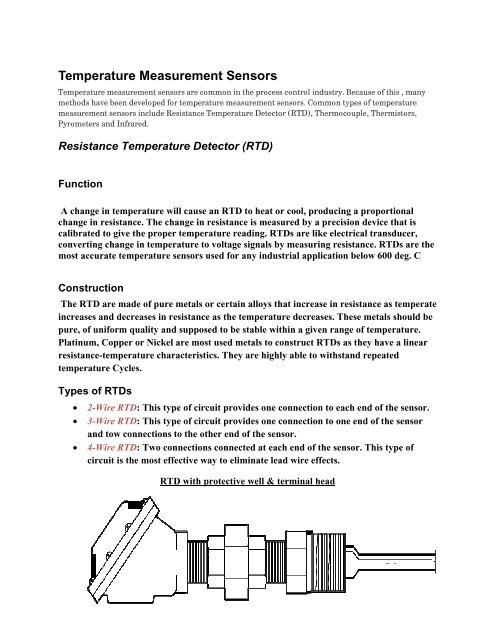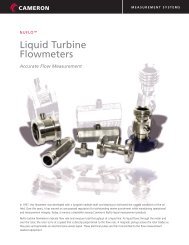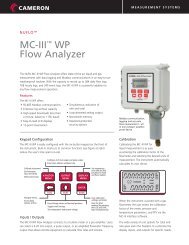Download Temperature Measurement Sensors White Paper (PDF)
Download Temperature Measurement Sensors White Paper (PDF)
Download Temperature Measurement Sensors White Paper (PDF)
You also want an ePaper? Increase the reach of your titles
YUMPU automatically turns print PDFs into web optimized ePapers that Google loves.
<strong>Temperature</strong> <strong>Measurement</strong> <strong>Sensors</strong><br />
<strong>Temperature</strong> measurement sensors are common in the process control industry. Because of this , many<br />
methods have been developed for temperature measurement sensors. Common types of temperature<br />
measurement sensors include Resistance <strong>Temperature</strong> Detector (RTD), Thermocouple, Thermistors,<br />
Pyrometers and Infrared.<br />
Resistance <strong>Temperature</strong> Detector (RTD)<br />
Function<br />
A change in temperature will cause an RTD to heat or cool, producing a proportional<br />
change in resistance. The change in resistance is measured by a precision device that is<br />
calibrated to give the proper temperature reading. RTDs are like electrical transducer,<br />
converting change in temperature to voltage signals by measuring resistance. RTDs are the<br />
most accurate temperature sensors used for any industrial application below 600 deg. C<br />
Construction<br />
The RTD are made of pure metals or certain alloys that increase in resistance as temperate<br />
increases and decreases in resistance as the temperature decreases. These metals should be<br />
pure, of uniform quality and supposed to be stable within a given range of temperature.<br />
Platinum, Copper or Nickel are most used metals to construct RTDs as they have a linear<br />
resistance-temperature characteristics. They are highly able to withstand repeated<br />
temperature Cycles.<br />
Types of RTDs<br />
• 2-Wire RTD: This type of circuit provides one connection to each end of the sensor.<br />
• 3-Wire RTD: This type of circuit provides one connection to one end of the sensor<br />
and tow connections to the other end of the sensor.<br />
• 4-Wire RTD: Two connections connected at each end of the sensor. This type of<br />
circuit is the most effective way to eliminate lead wire effects.<br />
RTD with protective well & terminal head
Thermocouples<br />
Function<br />
A device that converts thermal energy into electrical energy. Thermocouples cause an<br />
electric current to flow in the attached circuit when subjected to change in temperature.<br />
The amount of current produced depends on the temperature difference between the<br />
measurement and reference junction, the characteristics of the two metals used and the<br />
characteristics of the attached circuit.<br />
Construction<br />
Thermocouple is constructed of two dissimilar metal wires joined at one end. They may be<br />
constructed of several different combinations of materials.<br />
Dissimilar Metal Wire 1 +<br />
Dissimilar Metal Wire 2 -<br />
The performance of a thermocouple material is generally determined by using that<br />
material with platinum. The leads of the thermocouple are encased in a rigid metal sheath.<br />
The measuring junction is formed at the bottom of the thermocouple housing.<br />
Hot & Cold Junction<br />
The junction that is put into the process in which temperature is being measured is called<br />
the HOT JUNCTION. The other junction is at the last point of thermocouple material and<br />
which is almost always at some kind of measuring instruments, is called COLD<br />
JUNCTION.<br />
Types of Thermocouples<br />
Type Positive Wire Negative Wire Temp. Range
J Iron Constantan 32 to 1400 Deg. F<br />
K Chromel Alumel 32 to 2300 Deg. F<br />
T Copper Constantan -300 to 700 Deg. F<br />
E Chromel Constantan 32 to 1600 Deg. F
















